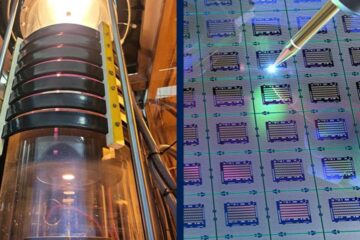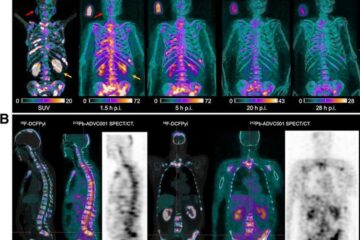New miniaturised chip dramatically reduces time taken for DNA analysis

The portable device will speed up performing paternity tests, identifying bacterial infections and detecting genetically modified organisms (GMOs)
A team of researchers at the Universitat Autònoma de Barcelona has developed new miniature sensors for analysing DNA. The sensors have the same size and thickness as a fingernail and reduce the time needed to identify DNA chains to several minutes or a few hours, depending on each chain. These sensors can be applied to many different tasks, ranging from paternity tests and identifying people to detecting genetically modified food, identifying bacterial strains in foodborne illnesses and testing genetic toxicity in new drugs. Once mass production of the sensors begins, their cost and availability will be similar to that of pregnancy test kits found in pharmacies.
The researchers Salvador Alegret, Manuel del Valle and Maria Isabel Pividori, all of whom are members of the Sensors and Biosensors Group at the UAB’s Department of Chemistry, developed the new sensors based on their experience in research with electrochemical sensors. These can identify a substance by chemically interacting with it and converting this interaction into an electrical current that they measure.
To detect DNA, the new miniaturised electrochemical genosensors have a probe containing DNA fragments that complement the DNA they aim to detect. For example, to detect Salmonella in a sample of mayonnaise, the probe has fragments of the type of DNA that complements that found in a group of genes that identify the bacteria. When the probe is submerged into the mayonnaise, some of the DNA fragments from the bacterial cells join the complementing fragments from the probe, creating a measurable electrical current. The sensor converts this current into a signal that can be seen by the person controlling the tests, making him aware there are bacteria. Also, because the sensors are very small and easy to manipulate, it is possible to assemble a set of sensors that can collect data simultaneously and deduce information about the bacteria such as which strain caused the foodborne illness.
This type of analysis already takes place in laboratories, but until now the experimental measures needed were not suitable for in situ analysis. By using the new sensors developed by UAB scientists, the time taken to identify the source of infection for Legionella would decrease from two days, as is currently the case using organic production techniques, to just thirty minutes. In trials developed with the support of the UAB’s Department of Genetics and Microbiology, the new sensors have enabled Salmonella to be identified in four and a half hours, compared to three to five days using the traditional microbiological methods. This method for identifying bacteria could also be used to detect other infectious agents such as Campylobacter and Listeria, and the sensor could easily be adapted for use in medicine, environmental monitoring and the industrial sector.
Other important applications for DNA sensors include: detecting genetically modified organisms in food, either in basic ingredients or in prepared food; identifying people, either to establish blood relations or to find criminal evidence; and testing the toxicity of different drugs to establish what damage they may cause to the DNA molecule of disease-causing microorganisms and of cells in patients.
“The next step is to mass-produce the sensors”, states Salvador Alegret, the director of research. “Mass production will allow costs to be reduced and the product to become as widely available as pregnancy test kits we can buy at the local pharmacy”.
Electrochemical genosensors vs DNA chips
Identifying DNA chains has become increasingly important in biochemistry, medicine and biotechnology. But traditional DNA-analysis techniques are becoming outdated as demand increases for more genetic information to be found in less time and at a lower cost. An important step forward in this direction was the creation of DNA chips, in which the UAB played a leading role in Catalonia. Hundreds, or even thousands, of genetic tests can be performed simultaneously with these chips, which are now a vital part of any large-scale project, such as unlocking the genetic code of an organism. DNA chips are limited to a certain extent because of some very specific analytical problems, such as establishing the source of microbial contamination quickly and efficiently. The new miniaturised electrochemical genosensors meet the current need for DNA to be analysed at a low cost with easy-to-use devices that do not need to be supervised by highly trained scientists.
Media Contact
More Information:
http://www.uab.esAll latest news from the category: Health and Medicine
This subject area encompasses research and studies in the field of human medicine.
Among the wide-ranging list of topics covered here are anesthesiology, anatomy, surgery, human genetics, hygiene and environmental medicine, internal medicine, neurology, pharmacology, physiology, urology and dental medicine.
Newest articles

Silicon Carbide Innovation Alliance to drive industrial-scale semiconductor work
Known for its ability to withstand extreme environments and high voltages, silicon carbide (SiC) is a semiconducting material made up of silicon and carbon atoms arranged into crystals that is…

New SPECT/CT technique shows impressive biomarker identification
…offers increased access for prostate cancer patients. A novel SPECT/CT acquisition method can accurately detect radiopharmaceutical biodistribution in a convenient manner for prostate cancer patients, opening the door for more…

How 3D printers can give robots a soft touch
Soft skin coverings and touch sensors have emerged as a promising feature for robots that are both safer and more intuitive for human interaction, but they are expensive and difficult…





















